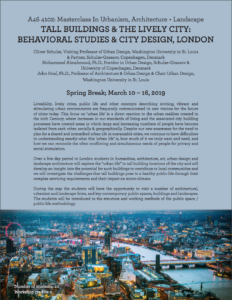Public Life Survey
Public space is designed physically and is mediated by the environment and social and cultural practices. The Public Life Survey is a methodology based on observations, interviews, measurements, photography and mapping to show how public spaces are actually used. Created on-site by a team of students with specific tasks, the three-day workshop produces a graphic description that can be compared with other cities.The survey’s goals are twofold: to better understand how public space is used (and misused), and to use this information to design new public spaces that contribute positively to the life of the city.
2022 Public Life Survey

As part of The Divided City Initiative, the Center for the Humanities offers support to graduate students in the humanities to participate in the Sam Fox School’s Graduate School of Architecture & Urban Design’s Public Life Survey in Copenhagen. In March of 2022, the Lively City workshop traveled to where it started ten years ago: Copenhagen, Denmark! Over a six-day period in Copenhagen, Denmark, students in humanities, architecture and urban design explored the “urban life” of the city and investigated the manner in which the capital of Denmark has made the revitalization and programming of their public spaces, a cornerstone of the city development vision.
The deadline to apply for this workshop has passed.
2019 Public Life Survey

2017 Public Life Survey
During March 2017 the Public Life Survey master class returned to Rotterdam, Netherlands for five days to study the relationship between the city’s public spaces and its position as a global city. A full description of the project goals, along with information about Rotterdam is available here.
2016 Public Life Survey
In March 2016, 20 graduate students in humanities, art, urban design and landscape architecture, along with 2 professors explored the “urban life” of the city and investigate the manner in which the City of Rotterdam has made the revitalization and programming of their public spaces a central strategy in its continued prominence as a major global city. They spent five days there and visited architecture and landscape architecture firms, as well as key contemporary public spaces, buildings and landscapes The course was titled The Lively City: Behavioral Studies & Public Space Design ROTTERDAM + AMSTERDAM and a full course description, along with an itinerary can be found here.
Damarias Moore, a participant in the 2016 Public Life Survey and a Humanities graduate student in Romance Languages and Literature, wrote of their experience during the Public Life Survey, explaining, “A week with architects and architecture students provided me with a fresh and practical perspective towards architecture and urban design that I will now be able to apply to my own studies. Public space and urban design are especially relevant to my interests in representations in French literature of government buildings built for marginalized and impoverished sectors of French society.” Read about Damarias’ full experience here.
2015 Public Life Survey
During 2015 spring break, graduate students and some faculty members traveled to Berlin for the Public Life Survey. In the current moment, liveability, lively cities, public life and other concepts describing inviting, vibrant and stimulating urban environments are frequently communicated in new visions for the future of cities today. However, despite our new awareness for the need to plan for a shared and intensified urban life in sustainable cities, we continue to have difficulties in understanding exactly what this ‘urban life’ is, how much of it we truly want and need, and how we can reconcile the often conflicting and simultaneous needs of people for privacy and social stimulation. One of the purpose of the Public Life Survey is to understand this “urban life” and its relationship to citizens. For five days, members of the The Lively City: Behavioral Studies & Public Space Design BERLIN course visited a variety of site and analyzed key public spaces utilizing the public space/public life methodology. A full course description along with an itinerary can be found here.



